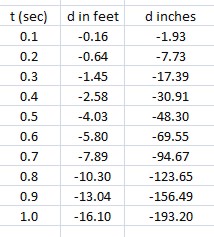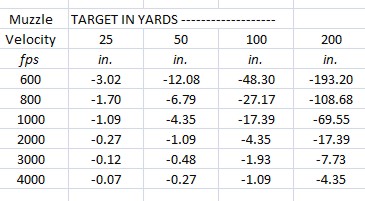|
|||||||||||||||||||||||||||||||||||||||||||||||||||||||||||||||||||||||||||||||||||||||||||||||||||||||||
|
Some Help for Windows Printer Spoolers
|
|||||||||||||||||||||||||||||||||||||||||||||||||||||||||||||||||||||||||||||||||||||||||||||||||||||||||
|
Simple Rifle Ballistics
FORWARD There are actually many forces on a pellet from an air rifle, or on a bullet from a more serious gunpowder version - as soon as it leaves the rifle barrel and nature takes over. The main ones are: muzzle velocity, gravity, wind resistance, wind itself (windage), shape of the pellet or bullet that will effect wind resistance, the angle the rifle is fired at, wind, and one can imagine that a most serious person also may even care about humidity and temperature, although those items might just affect the real value of wind resistance. And of course if the target is moving, one must lead the target - which means to guess where the target is going to be and shoot there instead. Whew! I imagine those not familiar with guns and rifles, as I was not so long ago, think you just pick them up and point and shoot. Nope. One of the largest effects is gravity itself, which we will spend the most time on on this page since it is the most behaved and likely often has the largest impact. But first, just some simple thoughts about wind resistance. Wind resistance is not easy to calculate, but some things you should know. The muzzle speed is the speed the pellet or bullet is traveling when it leaves the rifle. This speed is not going to get faster later, in fact wind resistance will slow it down over time. Muzzle velocity for an air gun is often in the range of 600 to 1000 fps - or feet per second. For air pump guns, it may depend on how much you pump it. The high end such as 1000 fps is most often seen with CO2 cartridges used in air rifles instead of pumping air into them by hand. Okay, now how about gunpowder type rifles, or real rifles if you prefer. My understanding is that muzzle velocities for them are much higher, and might be in the range of 2100 to 4000 fps or feet per second. |
|||||||||||||||||||||||||||||||||||||||||||||||||||||||||||||||||||||||||||||||||||||||||||||||||||||||||
 |
|||||||||||||||||||||||||||||||||||||||||||||||||||||||||||||||||||||||||||||||||||||||||||||||||||||||||
|
The second error that someone new might make, since I also had earlier made that one, is to misunderstand what gun manufacturers say. While an air rifle might be able to shoot 800 feet away, only an amazing marksman could use it for even most of that range. Likely effective target range is more like one fifth the published range. That is the period where the pellet or bullet behaves well and can be predicted the best during its flight. In other words - the first perhaps one fifth of its flight is where most of us humans have a chance of actually targeting and hitting something. Of course, I would agree that a real marksman or markswoman would have a much larger range they can operate in. WIND RESISTANCE - SOME ISSUES Okay, let us get back to wind resistance for a second. Since it depends on the shape of the pellet or bullet and depends on temperature, humidity and other stuff, we will not calculate it here. However, we should talk about something you likely know about - how aerodynamic is this pellet or bullet? The information I have seen says that round shaped heads (the normal bullet style) has the least wind resistance and is the most behaved in flight. Snub or blunt nosed pellets or bullets are going to have the most wind resistance and likely will be problems for long distance usage. Pointed pellets or bullets are the most irritating to animals (if that is your target) and are better aerodynamically then the blunt nosed or flat nosed pellets or bullets, but not as good as the round headed ones.
Then there is "rifling". Most rifle barrels are designed such that they have rifling built in. That spins the pellet or bullet when leaving the barrel helping it to fly more straight and true. If you have an air rifle and it gives a choice of bb's or pellets - note that the 0.177 pellets should be more accurate, since some air rifles are designed that a 0.177 size will take advantage of rifling and will help spin it and help keep it on course. The bb's meanwhile are often smaller diameter and just go bouncing down the barrel and will not get help for stability in flight. One more thing. Some pellets and even some bullets may be designed with a diabolo effect - which means a narrow waist that one might associate with females. This design I understand also helps stabilize pellets and helps keep them from tumbling in the air. So the best shaped pellet? A round head with a diabolo effect built in. But if your goal is to irritate animals with your air rifle to help convince them to stay out of your garden, many choose the pointed pellets which are almost as aerodynamic but more annoying to creatures. But just remember - muzzle velocity is the fastest your pellet or bullet will ever go in flight - and it will slow down a little with wind resistance. GRAVITY - THE BIG FOE When you are shooting your pellet or bullet forward, as soon as it leaves the rifle barrel, nature will use gravity to try and pull it down. How fast before it hits the ground? Well, if you just point your rifle absolutely level five feet off the ground, just drop the pellet or bullet from 5 feet off the ground and see how long it takes the hit the ground. One internet source said about hald a second. I admit that I did not time it. But even if this seems odd to you, it does not matter if the bullet is moving forward quickly. It will always fall at the same rate of speed. How does one Compensate for Gravity? How does one compensate for gravity? Glad you asked - since that is the main thing we have to do here. First you want to know what distance you are aiming for. let us say that you are using an air rifle and shooting 25 yards. The pellet you use will fall during its flight. So basically what you should do is to point the rifle up enough to compensate for that distance. The below graphs shows how fast a pellet or bullet falls versus the portion of a second - and that will tell you how much vertical distance you must correct for. If that seems complex, we will say more about it.
Now looking at the table one above, you likely will notice what I saw. There are many types of rifles - and one should use the right one for the right job. If you shooting short range, an air rifle is okay. Long range you will need a more normal gunpowder type. Why? Looking at that table, you are best if the time distance between you and your target is 0.2 seconds or less. That keeps adjustment for distance reasonable. Note that if the target is one second away - that you would have to compensate for it by 16 FEET !!! That means if it takes a second for your pellet or bullet to get there, you would need to aim 16 feet over the target in order to hit it. Best to pick the rifle for the right distance, keep the time to target 0.1, or 0.2 seconds or less and keep the correction needed easy if you can. So, does this mean you would aim above the target by the number in Table 1 to compensate for gravity? You could do that. Most of us are too lazy for that one though. You can also adjust the sights on your rifle or your rifle scope to take this into account, so you can just aim and shoot. Of course we all need to understand that if you adjust your rifle sights or scopes to compensate for gravity, you can only do that for one distance at a time. In my case I adjust my air rifle for about 30 yards - since that is the normal distance I am away from pesky rabbits destroying my lawn. How to adjust a scope we have information if you click here - to compensate for gravity so less thinking is required. THE RIGHT "TOOL" FOR THE RIGHT JOB The below chart shows the adjustment needed for different rifles with different muzzle velocities versus distance of target. What it says to me is that air rifles with a muzzle velocity of 600 to 1000 fps (feet per second) will be best in the 25 to 50 yard range, whereas gunpowder rifle version can also do quite well at 100 yard or even 200 yard targets.
LEADING THE TARGET If a target is moving, such as a skeet shoot or an animal, how much must you lead it by. Well, you will have to know about how long your pellet or bullet takes to get near the target area in fractions of a second, and also how fast that object can move if it moves towards the side giving it the most movement. Below is a table that can help you approximate how much to lead a moving target. You need to know about how fast in mph the target is going or can go, and also the fraction of a second for your pellet to get there. The answers in the chart are in feet to lead the target by.
Want more detail? We at rpsoft 2000 software have now included a Hunting calculator in with our "convert" series of calculators that now have 9 total calculator types. That software allows you to adjust for your own rifle specifics and distance specifics. You can find it here at: Hope This helps!
|
|||||||||||||||||||||||||||||||||||||||||||||||||||||||||||||||||||||||||||||||||||||||||||||||||||||||||
|
|||||||||||||||||||||||||||||||||||||||||||||||||||||||||||||||||||||||||||||||||||||||||||||||||||||||||


